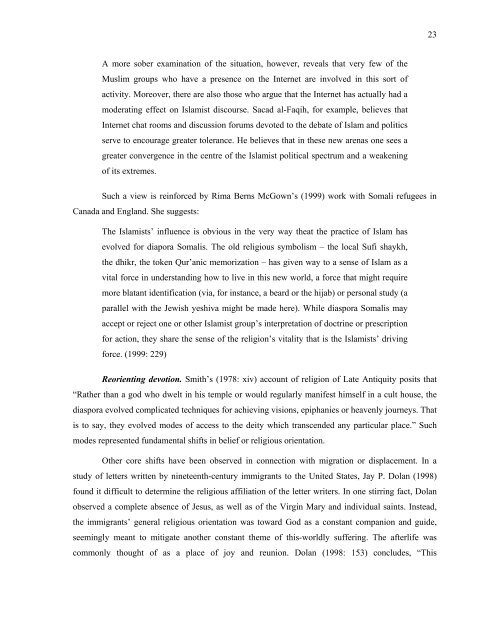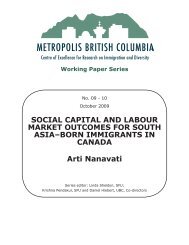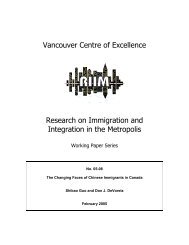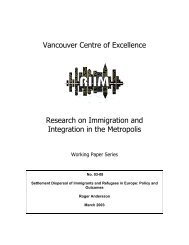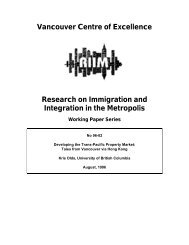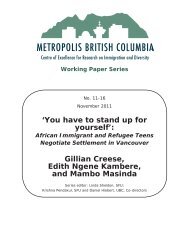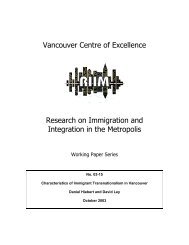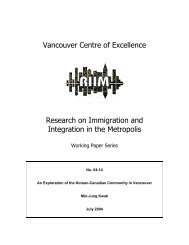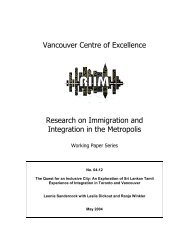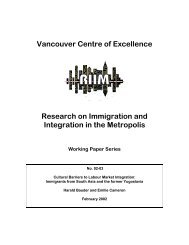Religion in Migration, Diasporas and Transnationalism - Metropolis BC
Religion in Migration, Diasporas and Transnationalism - Metropolis BC
Religion in Migration, Diasporas and Transnationalism - Metropolis BC
Create successful ePaper yourself
Turn your PDF publications into a flip-book with our unique Google optimized e-Paper software.
23<br />
A more sober exam<strong>in</strong>ation of the situation, however, reveals that very few of the<br />
Muslim groups who have a presence on the Internet are <strong>in</strong>volved <strong>in</strong> this sort of<br />
activity. Moreover, there are also those who argue that the Internet has actually had a<br />
moderat<strong>in</strong>g effect on Islamist discourse. Sacad al-Faqih, for example, believes that<br />
Internet chat rooms <strong>and</strong> discussion forums devoted to the debate of Islam <strong>and</strong> politics<br />
serve to encourage greater tolerance. He believes that <strong>in</strong> these new arenas one sees a<br />
greater convergence <strong>in</strong> the centre of the Islamist political spectrum <strong>and</strong> a weaken<strong>in</strong>g<br />
of its extremes.<br />
Such a view is re<strong>in</strong>forced by Rima Berns McGown’s (1999) work with Somali refugees <strong>in</strong><br />
Canada <strong>and</strong> Engl<strong>and</strong>. She suggests:<br />
The Islamists’ <strong>in</strong>fluence is obvious <strong>in</strong> the very way theat the practice of Islam has<br />
evolved for diapora Somalis. The old religious symbolism – the local Sufi shaykh,<br />
the dhikr, the token Qur’anic memorization – has given way to a sense of Islam as a<br />
vital force <strong>in</strong> underst<strong>and</strong><strong>in</strong>g how to live <strong>in</strong> this new world, a force that might require<br />
more blatant identification (via, for <strong>in</strong>stance, a beard or the hijab) or personal study (a<br />
parallel with the Jewish yeshiva might be made here). While diaspora Somalis may<br />
accept or reject one or other Islamist group’s <strong>in</strong>terpretation of doctr<strong>in</strong>e or prescription<br />
for action, they share the sense of the religion’s vitality that is the Islamists’ driv<strong>in</strong>g<br />
force. (1999: 229)<br />
Reorient<strong>in</strong>g devotion. Smith’s (1978: xiv) account of religion of Late Antiquity posits that<br />
“Rather than a god who dwelt <strong>in</strong> his temple or would regularly manifest himself <strong>in</strong> a cult house, the<br />
diaspora evolved complicated techniques for achiev<strong>in</strong>g visions, epiphanies or heavenly journeys. That<br />
is to say, they evolved modes of access to the deity which transcended any particular place.” Such<br />
modes represented fundamental shifts <strong>in</strong> belief or religious orientation.<br />
Other core shifts have been observed <strong>in</strong> connection with migration or displacement. In a<br />
study of letters written by n<strong>in</strong>eteenth-century immigrants to the United States, Jay P. Dolan (1998)<br />
found it difficult to determ<strong>in</strong>e the religious affiliation of the letter writers. In one stirr<strong>in</strong>g fact, Dolan<br />
observed a complete absence of Jesus, as well as of the Virg<strong>in</strong> Mary <strong>and</strong> <strong>in</strong>dividual sa<strong>in</strong>ts. Instead,<br />
the immigrants’ general religious orientation was toward God as a constant companion <strong>and</strong> guide,<br />
seem<strong>in</strong>gly meant to mitigate another constant theme of this-worldly suffer<strong>in</strong>g. The afterlife was<br />
commonly thought of as a place of joy <strong>and</strong> reunion. Dolan (1998: 153) concludes, “This


